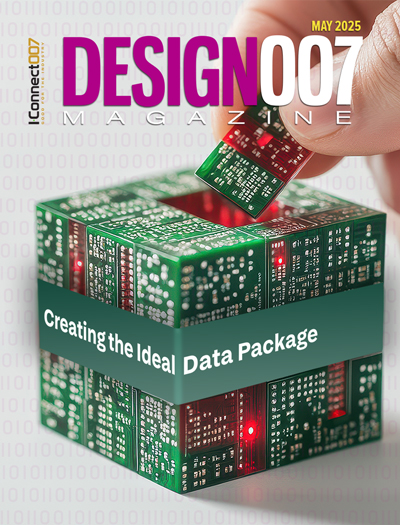-

- News
- Books
Featured Books
- design007 Magazine
Latest Issues
Current Issue
Creating the Ideal Data Package
Why is it so difficult to create the ideal data package? Many of these simple errors can be alleviated by paying attention to detail—and knowing what issues to look out for. So, this month, our experts weigh in on the best practices for creating the ideal design data package for your design.

Designing Through the Noise
Our experts discuss the constantly evolving world of RF design, including the many tradeoffs, material considerations, and design tips and techniques that designers and design engineers need to know to succeed in this high-frequency realm.

Learning to Speak ‘Fab’
Our expert contributors clear up many of the miscommunication problems between PCB designers and their fab and assembly stakeholders. As you will see, a little extra planning early in the design cycle can go a long way toward maintaining open lines of communication with the fab and assembly folks.
- Articles
- Columns
Search Console
- Links
- Media kit
||| MENU - design007 Magazine
The Gerber Guide, Chapter 2
October 5, 2015 | Karel Tavernier, UcamcoEstimated reading time: 2 minutes
It is clearly possible to fabricate PCBs from the fabrication data sets currently being used; it's being done innumerable times every day all over the globe. But is it being done in an efficient, reliable, automated and standardized manner? At this moment in time, the honest answer is no, because there is plenty of room for improvement in the way in which PCB fabrication data is currently transferred from design to fabrication.
This is not about the Gerber format, which is used for more than 90% of the world's PCB production. There are very rarely problems with Gerber files themselves; they allow images to be transferred without a hitch. In fact the Gerber format is part of the solution, given that it is the most reliable option in this field. The problems actually lie in which images are transferred, how the format is used and, more often, in how it is not used.
In this monthly series, I will explain in detail how to use the newly revised Gerber data format to communicate with your fabrication partners clearly and simply, using an unequivocal yet versatile language that enables you and them to get the very best out of your design data. Each month we’ll look at a different aspect of the design to fabrication data transfer process.
This column has been excerpted from the Guide to PCB Fabrication Data: Design to Fabrication Data Transfer.
Chapter 2: Alignment (Registration)
Never mirror or flip layers! All layers must be viewed from the top of the PCB, which means that the text must be readable on the top layer and mirrored on the bottom layer. Alas, sometimes, in a mistaken attempt to be helpful, designers flip layers because they must anyway be mirrored on the photoplotter. This could be helpful in a world where the designer's files are used directly in fabrication, but these data layers are actually input for the CAM system. This needs the correct 2.5D PC structure, so designers need to follow the standard protocol for providing digital data. The fabricator's CAM system will do the rest: it will optimise and panelise the PCB and on output of the final, panelised data, it will mirror, rotate, shift and scale as required by production. Any designer that mirrors layers can only hope that the CAM engineer notices this and ‘unmirrors’ them.
To read this entire article, which appeared in the September 2015 issue of The PCB Design Magazine, click here.
Suggested Items
The Shaughnessy Report: Solving the Data Package Puzzle
05/12/2025 | Andy Shaughnessy -- Column: The Shaughnessy ReportIf you ask fabricators about their biggest challenges, they’ll often point at PCB designers—the readers of this magazine. Yes, you! Why is it so difficult to create the ideal data package? It’s a fairly straightforward task. But this part of the design process keeps tripping up designers, even those who started in the industry before Pink Floyd split up.
I-Connect007 Editor’s Choice: Five Must-Reads for the Week
05/09/2025 | Andy Shaughnessy, Design007 MagazineTrade show season is wrapping up as we head into summer. Where has the time gone? I hope you all get the chance to take a vacation this year, because I know you’ve earned one. Speaking of which, when was my last vacay? If I can’t remember, it’s probably time for one. It’s been a busy week in electronics, with fallout from the back-and-forth on tariffs taking up most of the oxygen in the room. We have quite an assortment of articles and columns for you in this installment of Must-Reads. See you next time.
Imec Coordinates EU Chips Design Platform
05/09/2025 | ImecA consortium of 12 European partners, coordinated by imec, has been selected in the framework of the European Chips Act to develop the EU Chips Design Platform.
New Issue of Design007 Magazine: Are Your Data Packages Less Than Ideal?
05/09/2025 | I-Connect007 Editorial TeamWhy is it so difficult to create the ideal data package? Many of these simple errors can be alleviated by paying attention to detail—and knowing what issues to look out for. So, this month, our experts weigh in on the best practices for creating the ideal data package for your design.
RF PCB Design Tips and Tricks
05/08/2025 | Cherie Litson, EPTAC MIT CID/CID+There are many great books, videos, and information online about designing PCBs for RF circuits. A few of my favorite RF sources are Hans Rosenberg, Stephen Chavez, and Rick Hartley, but there are many more. These PCB design engineers have a very good perspective on what it takes to take an RF design from schematic concept to PCB layout.


